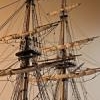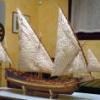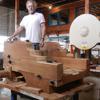-
Posts
1,267 -
Joined
-
Last visited
Reputation Activity
-
 AnobiumPunctatum got a reaction from Eddie in HM Sloop Fly by AnobiumPunctatum - 1:32 - POF
AnobiumPunctatum got a reaction from Eddie in HM Sloop Fly by AnobiumPunctatum - 1:32 - POF
All frames are drawn and I started to build the keel.
Thanks for your interest and
and a Happy New Year
-
 AnobiumPunctatum got a reaction from Eddie in HM Sloop Fly by AnobiumPunctatum - 1:32 - POF
AnobiumPunctatum got a reaction from Eddie in HM Sloop Fly by AnobiumPunctatum - 1:32 - POF
I've finished the "Disposition of Frames" drawing.
I am not quite happy with the position of the timberheads between station line 17 and 19. But this is the position I got from the As Built plan of the Fly.
Next I will built my building board and start with the model.
-
 AnobiumPunctatum got a reaction from Eddie in HM Sloop Fly by AnobiumPunctatum - 1:32 - POF
AnobiumPunctatum got a reaction from Eddie in HM Sloop Fly by AnobiumPunctatum - 1:32 - POF
Today it rained all day, so I had enough time to finish the design of the cant frames
The Bollard Timbers and Hawse Pieces are missing to complete the planning of framework.
The individual components and the frames I'll draw later during the build.
Next, the construction of the two-stage slipway is on the ToDo list, then I can lay down the keel for the model.
-
 AnobiumPunctatum got a reaction from KenW in HM Sloop Fly by AnobiumPunctatum - 1:32 - POF
AnobiumPunctatum got a reaction from KenW in HM Sloop Fly by AnobiumPunctatum - 1:32 - POF
Welcome on bord, Antony
The completion of the hull of my control model in the region behind the last frames has attracted much longer than expected.
When planning the last phase of the construction I realized that the body plan of the original drawing and therefore my reconstruction at the top of the last two frames is too narrow. So back to the drawing board and the frames 19 and 20 newly constructed. The hull at frames 20 is now about 1 mm wider in the region of maximum breath than originally. With the help of several buttok lines and the new water lines I have also redesigned the transoms
I haven't add all changes on the test hull, so you can see in the pictures the not entirely harmonious course of the lines.
The first step of my little project -the reconstruction of the lines- is complete.
In between, I have asked myself several times whether the construction of the half-model was even necessary. After the problems in the reconstruction of the transoms and fashion pieces, that define the shape of the stern, have identified, the construction of the test model was more than worth. I am happy to have the mistakes now and not found during the construction of the POF model.
In the next few weeks I'll construct keel, frames and all other components that are needed to build the hull. In autumn I like to start the construction of the POF model. Until then, one last picture which shows the side view of the test hull.
-
 AnobiumPunctatum got a reaction from Eddie in HM Sloop Fly by AnobiumPunctatum - 1:32 - POF
AnobiumPunctatum got a reaction from Eddie in HM Sloop Fly by AnobiumPunctatum - 1:32 - POF
Then I've started sanding the hull. I've used 60 grid until 120 grid sandpaper for the process. After around one week - I can only work on my model in the evening or at the weekends- I've finished the front half of my control model.
I am very happy with the result
To check the curves I use 1mm thick stripes of maple. The found differences are very small. So I think that my reconstruction will work for the checked range.
-
 AnobiumPunctatum got a reaction from Eddie in HM Sloop Fly by AnobiumPunctatum - 1:32 - POF
AnobiumPunctatum got a reaction from Eddie in HM Sloop Fly by AnobiumPunctatum - 1:32 - POF
With the build of my control model I started at the end of March.
The edges of all frames I've colored black. This will be later a great help by sandig the hull.
The glued surface of the cant frames is very small, so I've glued first plywood stripes on the center board.
To get the correct alignment the colored 5' marks on the frames and the center board are a great help.
First half of frame 0
Six frames have been installed.
At this time I've started to glue the filling pieces of polar plywood between the frames. I've used a chess board pattern to avoid the distortion of the frames.
Until the mid of April I've installed all frames and filling pieces from the center to the stem on the stem.
The next two pictures show the result of the work. It's looking very horrible
-
 AnobiumPunctatum got a reaction from Eddie in HM Sloop Fly by AnobiumPunctatum - 1:32 - POF
AnobiumPunctatum got a reaction from Eddie in HM Sloop Fly by AnobiumPunctatum - 1:32 - POF
To check the lines I started to build a half model. For the frames I use 3mm birch plywood, it's for a model in 1/32 perhaps a little small, but I've had a bigger batch at home. All space between the frames I fill with poplar plywood. It's easy to shape but stable enough for the purpose.
I glue the drawngs with rubber cement on the ply woord
With a sharp knife I mark every 5' line. The picture shows frame 0:
All bulkheades and the center are cutted out. The hull has a length of around 1m, which is not as big compared with the new 1/200 model kits of the WWII battle ships.
-
 AnobiumPunctatum got a reaction from Eddie in HM Sloop Fly by AnobiumPunctatum - 1:32 - POF
AnobiumPunctatum got a reaction from Eddie in HM Sloop Fly by AnobiumPunctatum - 1:32 - POF
Part 1 Reconstruction of the hull lines
David Antscherl wrote in his wonderful series about th Swan Class Sloop, that there are a lot of smaller differences between the ships of the class, for example the knee of the head of Fly.
As first decision for my new start I decided not to use the general lines, which David has published. I want to do my own reconstruction. The naval cutter was a first exercise for this project. In January I started with the reconstruction. At the end of February I had a first version of my body plan, which matchs the lines of the historical drawing very well.
-
 AnobiumPunctatum got a reaction from Eddie in HM Sloop Fly by AnobiumPunctatum - 1:32 - POF
AnobiumPunctatum got a reaction from Eddie in HM Sloop Fly by AnobiumPunctatum - 1:32 - POF
The Swan Class Sloop and I have as some of you know a longer history. Two years ago I started my build log for the build in 1/48. A few month later I had to stop the build because I got some problems with my eyes. At the beginning of this year I started again. I decided to change the scale of my build to 1/32.
I hope that some of you are intersted in my build and like to follow my log.
So let's start again
-
 AnobiumPunctatum got a reaction from Archi in HM Sloop Fly by AnobiumPunctatum - 1:32 - POF
AnobiumPunctatum got a reaction from Archi in HM Sloop Fly by AnobiumPunctatum - 1:32 - POF
All frames are drawn and I started to build the keel.
Thanks for your interest and
and a Happy New Year
-
 AnobiumPunctatum got a reaction from Eddie in HM Sloop Fly by AnobiumPunctatum - 1:32 - POF
AnobiumPunctatum got a reaction from Eddie in HM Sloop Fly by AnobiumPunctatum - 1:32 - POF
Today I've finished the drawing work for the frames. 55 frames and 26 cant frames are a lot stuff, which I have to build now.
The following picture shows frame 10a for example.
Now I have to clean up my work room and prepare the building board. I hope I've nothing forgotten so that I can make sawdust and start the build of my model
-
 AnobiumPunctatum got a reaction from Captain Poison in HM Sloop Fly by AnobiumPunctatum - 1:32 - POF
AnobiumPunctatum got a reaction from Captain Poison in HM Sloop Fly by AnobiumPunctatum - 1:32 - POF
Today it rained all day, so I had enough time to finish the design of the cant frames
The Bollard Timbers and Hawse Pieces are missing to complete the planning of framework.
The individual components and the frames I'll draw later during the build.
Next, the construction of the two-stage slipway is on the ToDo list, then I can lay down the keel for the model.
-
 AnobiumPunctatum got a reaction from Eddie in HM Sloop Fly by AnobiumPunctatum - 1:32 - POF
AnobiumPunctatum got a reaction from Eddie in HM Sloop Fly by AnobiumPunctatum - 1:32 - POF
Thanks Johann, druxey, Mike and Nils for your nice comments and all others for the Likes
Next I've installed all bulkheads until frame 20 and the filling pieces.
Then my favourite pastime - sanding
-
 AnobiumPunctatum got a reaction from Eddie in HM Sloop Fly by AnobiumPunctatum - 1:32 - POF
AnobiumPunctatum got a reaction from Eddie in HM Sloop Fly by AnobiumPunctatum - 1:32 - POF
Docmuents (I will update the list during my build):
NMM drawings:
ZAZ4667: Line & inboard profile, decoration of 'Fly' ZAZ4669: Lower & Platform Decks of 'Fly' ZAZ4670: Quarter and Upper deck plan of 'Fly ZAZ4691: Disposition of Frames of 'Cygnet' Books:
David Antscherl, "The Fully Framed Model, HMN Swan Class Sloops 1767-1780", Volume 1 - 4 David Antscherl, "Swan class sheer and profile, scale 1:48", corrected frames Allan Yedlinsky: Scantlings of Royal Navy ships David White: Understanding ship draughts David Antscherl: Understanding Eighten-Century Admirality drafts -
 AnobiumPunctatum got a reaction from PeteB in HMS Naiad 1797 by GDM67 - 1:60 - using Ed Tosti Books
AnobiumPunctatum got a reaction from PeteB in HMS Naiad 1797 by GDM67 - 1:60 - using Ed Tosti Books
Be careful with black paper. I've the exerience that the gluing is not stable. The problem is that paper has different layers and the wood glue will not go through all. I prefer black pulp, which I found in an hobby store. It has only one layer.
-
 AnobiumPunctatum got a reaction from Fam in HM Sloop Fly by AnobiumPunctatum - 1:32 - POF
AnobiumPunctatum got a reaction from Fam in HM Sloop Fly by AnobiumPunctatum - 1:32 - POF
All frames are drawn and I started to build the keel.
Thanks for your interest and
and a Happy New Year
-
 AnobiumPunctatum got a reaction from Captain Poison in HM Sloop Fly by AnobiumPunctatum - 1:32 - POF
AnobiumPunctatum got a reaction from Captain Poison in HM Sloop Fly by AnobiumPunctatum - 1:32 - POF
Today I've finished the drawing work for the frames. 55 frames and 26 cant frames are a lot stuff, which I have to build now.
The following picture shows frame 10a for example.
Now I have to clean up my work room and prepare the building board. I hope I've nothing forgotten so that I can make sawdust and start the build of my model
-
 AnobiumPunctatum got a reaction from ggrieco in HM Sloop Fly by AnobiumPunctatum - 1:32 - POF
AnobiumPunctatum got a reaction from ggrieco in HM Sloop Fly by AnobiumPunctatum - 1:32 - POF
Today it rained all day, so I had enough time to finish the design of the cant frames
The Bollard Timbers and Hawse Pieces are missing to complete the planning of framework.
The individual components and the frames I'll draw later during the build.
Next, the construction of the two-stage slipway is on the ToDo list, then I can lay down the keel for the model.
-
 AnobiumPunctatum got a reaction from Jeronimo in HMS Naiad 1797 by GDM67 - 1:60 - using Ed Tosti Books
AnobiumPunctatum got a reaction from Jeronimo in HMS Naiad 1797 by GDM67 - 1:60 - using Ed Tosti Books
Be careful with black paper. I've the exerience that the gluing is not stable. The problem is that paper has different layers and the wood glue will not go through all. I prefer black pulp, which I found in an hobby store. It has only one layer.
-
 AnobiumPunctatum got a reaction from mrjimmy in HM Sloop Fly by AnobiumPunctatum - 1:32 - POF
AnobiumPunctatum got a reaction from mrjimmy in HM Sloop Fly by AnobiumPunctatum - 1:32 - POF
All frames are drawn and I started to build the keel.
Thanks for your interest and
and a Happy New Year
-
 AnobiumPunctatum got a reaction from Captain Poison in HM Sloop Fly by AnobiumPunctatum - 1:32 - POF
AnobiumPunctatum got a reaction from Captain Poison in HM Sloop Fly by AnobiumPunctatum - 1:32 - POF
I've finished the "Disposition of Frames" drawing.
I am not quite happy with the position of the timberheads between station line 17 and 19. But this is the position I got from the As Built plan of the Fly.
Next I will built my building board and start with the model.
-
 AnobiumPunctatum got a reaction from Eddie in HM Sloop Fly by AnobiumPunctatum - 1:32 - POF
AnobiumPunctatum got a reaction from Eddie in HM Sloop Fly by AnobiumPunctatum - 1:32 - POF
@Ed
Thank you. I use also the waterlines of the half breath plan. I am sure that's a lot more work to draw this manually because it was more than enough work with my CAD.
You're right. But it made a lot of fun to do this exercise.
Also I had some points I want to check with the drawing. On the Half Breath Plan were only the positions and angles of every second cant frame given. I wanted to check the reconstrction of the other cants. What's with the position of the gun ports? WHich cant frames do I have to shift? Is every timberhead given in the Sheer and Profile drawing on top of a frame?
If I compared the position of the timberheads given in the Sheer and Profile of Fly and in the DOF plan of Cygnet, I found some alterations, for example at the fore cants. I wanted to check the consequences for the frame design.
@druxey
I've checked the position of all timberheads of the Sheer and Profile drawing and my reconstruction again. At the after cant frames I found two timberheads whose position do not really match with my cants. The position of the other four timberheads is ok.
So I think to change my design will not solve the problem.
What do you think is the better solution? To move the timberhead or to add a timber between the frames and not to change the position.
@all
Thanks for your interest and hints, which I really appreciate.
-
 AnobiumPunctatum got a reaction from harvey1847 in HMS Naiad 1797 by GDM67 - 1:60 - using Ed Tosti Books
AnobiumPunctatum got a reaction from harvey1847 in HMS Naiad 1797 by GDM67 - 1:60 - using Ed Tosti Books
Be careful with black paper. I've the exerience that the gluing is not stable. The problem is that paper has different layers and the wood glue will not go through all. I prefer black pulp, which I found in an hobby store. It has only one layer.
-
 AnobiumPunctatum got a reaction from avsjerome2003 in HM Sloop Fly by AnobiumPunctatum - 1:32 - POF
AnobiumPunctatum got a reaction from avsjerome2003 in HM Sloop Fly by AnobiumPunctatum - 1:32 - POF
All frames are drawn and I started to build the keel.
Thanks for your interest and
and a Happy New Year
-
 AnobiumPunctatum got a reaction from ggrieco in HM Sloop Fly by AnobiumPunctatum - 1:32 - POF
AnobiumPunctatum got a reaction from ggrieco in HM Sloop Fly by AnobiumPunctatum - 1:32 - POF
Today I've finished the drawing work for the frames. 55 frames and 26 cant frames are a lot stuff, which I have to build now.
The following picture shows frame 10a for example.
Now I have to clean up my work room and prepare the building board. I hope I've nothing forgotten so that I can make sawdust and start the build of my model











